Kamakura, a historic city in Japan, offers visitors an unparalleled cultural experience. The city’s crown jewel is the remarkable 11-meter-tall wooden Buddha statue, a breathtaking representation of the Goddess of Mercy. Beyond this iconic landmark, Kamakura‘s renowned temples, such as the serene Hase Temple, immerse guests in Japan’s rich spiritual heritage. Exploring the temple grounds, guests can wander through meticulously-tended gardens adorned with vibrant seasonal blooms, capturing unforgettable moments. What secrets await those who venture further into Kamakura’s timeless allure?
Key Points

- Hase Temple in Kamakura features the largest wooden Buddha statue in Japan, an 11-meter-tall Kannon statue carved in the 8th century.
- The temple’s expansive grounds offer a glimpse into Japan’s cultural heritage, with traditional architecture, serene gardens, and a Kannon Museum showcasing Buddhist artworks.
- Hase Temple attracts both local and foreign visitors, who come to experience the temple’s rich history, spiritual significance, and seasonal floral displays.
- The temple tour includes entrance fees to Hase Temple and the Kannon Museum, providing a comprehensive cultural experience.
- The tour is not suitable for wheelchair users or individuals with low fitness levels, as the temple grounds may be challenging to navigate.
Overview of Hase Temple
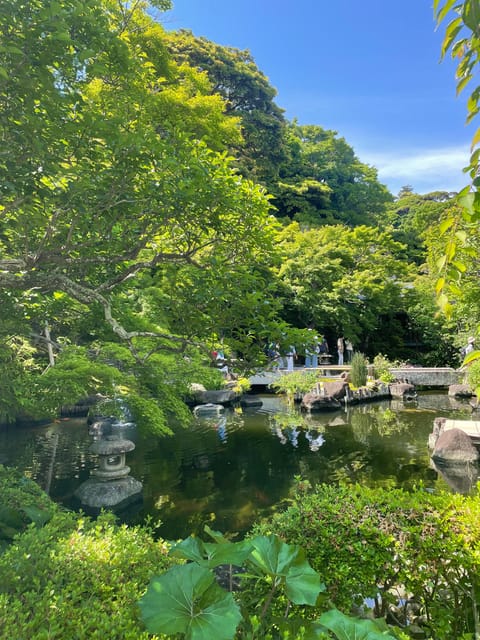
Hase Temple, founded in 736, is a renowned destination in Kamakura that attracts both locals and foreign visitors.
It’s famous for its rich history, cultural significance, beautiful gardens, and scenic views.
The temple grounds feature traditional Japanese architecture and provide stunning vistas of the nearby coastline and city.
Visitors can explore the expansive temple complex, admiring its architectural and spiritual elements.
The temple’s centerpiece is the 11-meter-tall wooden statue of Kannon, the Goddess of Mercy, showcasing remarkable craftsmanship and devotion from centuries ago.
Hase Temple offers a unique glimpse into Japan’s cultural heritage and spiritual traditions.
You can also read our reviews of more tours and experiences in Kamakura.
Magnificent Wooden Buddha Statue

The centerpiece of Hase Temple’s rich history and cultural significance is its magnificent wooden Buddha statue, an 11-meter-tall representation of Kannon, the Goddess of Mercy.
This colossal statue showcases remarkable craftsmanship and spiritual devotion from centuries ago. Visitors can marvel at the statue’s intricate details and the profound sense of serenity it evokes. The statue’s sheer size and artistry make it a true highlight of the temple experience.
- The statue was carved in the 8th century and has been a beloved icon for centuries.
- It’s the largest wooden Buddha statue in Japan, a testament to the skilled artistry of its creators.
- The statue’s serene expression and graceful pose inspire contemplation and reverence among visitors.
Exploring the Temple Grounds

Beyond the awe-inspiring sight of the grand wooden Buddha, visitors can explore the expansive temple grounds of Hase.
Wandering the tranquil gardens, they’ll discover a wealth of architectural gems, from ornate gates to historic halls. Meticulously maintained pathways lead past seasonal flowers, ponds, and stone bridges, inviting moments of serene contemplation.
At the main hall, worshippers gather to pray before the altar, while others browse the Kannon Museum‘s collection of Buddhist artworks.
Throughout the grounds, the temple’s rich heritage and enduring spiritual significance are palpable, providing a holistic cultural experience for all who visit.
Seasonal Floral Gardens
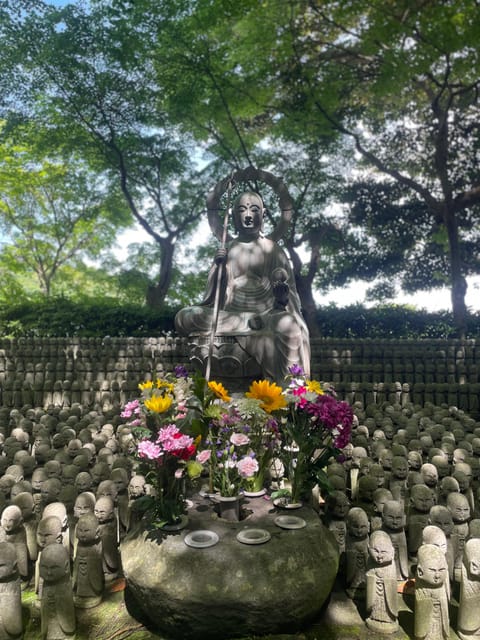
As visitors meander through the expansive temple grounds, they’ll be captivated by the vibrant floral displays that adorn the gardens throughout the year.
The gardens showcase:
- Stunning cherry blossoms in spring, painting the landscape in shades of pink and white.
- Lush greenery and colorful azaleas in summer, creating a serene and picturesque ambiance.
- Vivid autumn foliage in the fall, transforming the gardens into a breathtaking tapestry of warm hues.
These seasonal florals offer a visual feast, complementing the temple’s architectural splendor and providing a tranquil escape for visitors to enjoy the beauty of nature.
More Great Thing To Do NearbyOpportunities for Photography
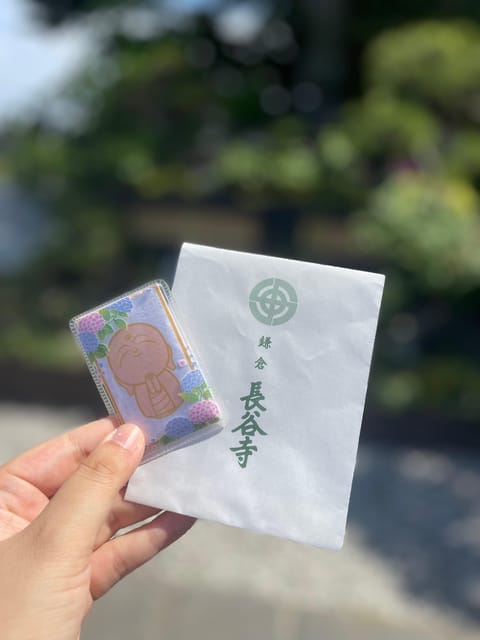
With the temple’s captivating architecture and the surrounding natural scenery, visitors can’t help but be inspired to capture the beauty through their lenses.
Whether it’s the grand wooden Buddha statue, the intricate temple roofs, or the breathtaking views of the coastline, there are ample photographic opportunities at Hase Temple.
Visitors can snap shots of the vibrant seasonal flowers in the gardens or the mesmerizing interplay of light and shadow within the temple grounds.
The temple’s tranquil atmosphere also provides a serene backdrop for contemplative photographs.
Skilled photographers can effortlessly immortalize the essence of this cultural and historical gem.
- Kamakura: Great Buddha, Hase Temple, & Komachi Street Tour
- Full Day Kamakura Private Tour With English Speaking Driver
- Kamakura: Full Day Private Tour With English Guide
- From Tokyo: Kamakura Private Customize Tour by Luxury Van
- Kamakura: Private History and Heritage Tour by Rickshaw
- Kamakura Through Time (Hiking, Writing Sutras…)
Quiet Contemplation

Aside from the ample photographic opportunities, visitors to Hase Temple can also enjoy moments of quiet contemplation.
The tranquil gardens and serene temple grounds offer a peaceful respite from the hustle and bustle of daily life.
Visitors can:
- Sit on a wooden bench and gaze upon the towering Kannon statue, allowing the spiritual significance to resonate within.
- Stroll along the winding paths, taking in the sights and sounds of nature, and find a quiet spot to meditate.
- Explore the temple’s smaller shrines and alcoves, each providing a unique opportunity for introspection and personal reflection.
Tour Details and Pricing
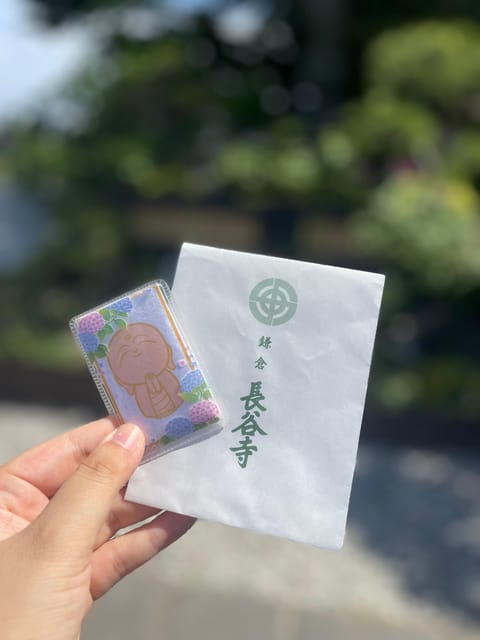
The Hase Temple tour offers visitors a comprehensive experience, starting at Kč 1,573 per person. Reservations can be made with free cancellation up to 24 hours in advance for a full refund. The option to reserve now and pay later allows travelers to keep plans flexible.
| Inclusions | Duration | Group Size | Meeting Point |
|---|---|---|---|
| Hase Temple entrance fee | 3 hours | Max 8 | Tullys Coffee, Kamakura |
| Kannon Museum entrance fee | Kanagawa | ||
| Hase Temple Main Hall access |
The tour is not suitable for wheelchair users or individuals with low fitness levels, ensuring a comfortable and accessible experience for all.
Meeting Point and Accessibility
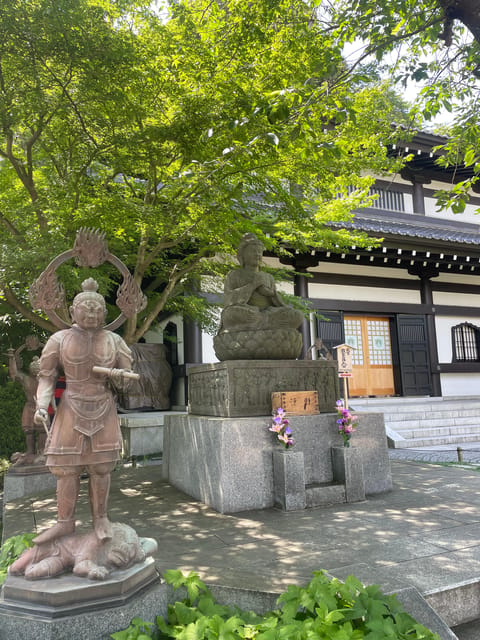
The meeting point for the Hase Temple tour is Tullys Coffee in Kamakura, Kanagawa. This location provides a convenient starting point for the cultural experience.
While the tour isn’t suitable for wheelchair users or individuals with low fitness levels, the temple grounds offer the following accessibility features:
- Paved walkways throughout the temple complex
- Handrails along staircases and ramps
- Designated areas for quiet contemplation and photography
Visitors should be prepared for some moderate walking and be aware of the temple’s accessibility limitations before booking the tour.
Frequently Asked Questions
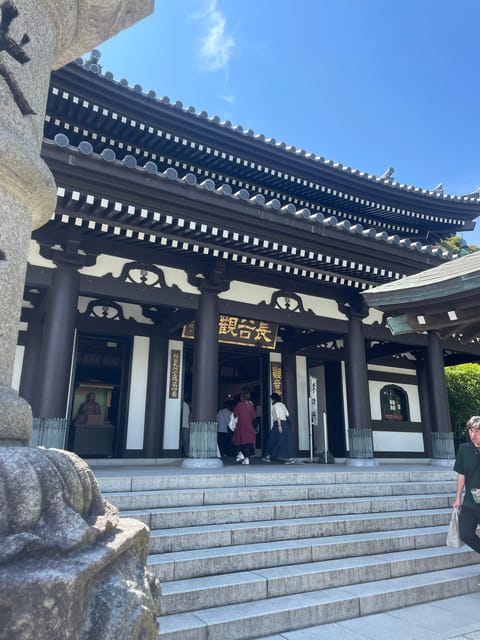
Can Visitors Interact With the Monks During the Tour?
Visitors can observe and learn about the temple’s monks during the tour, but direct interaction is typically limited to preserve the spiritual nature of the experience. The focus remains on appreciating the temple’s architecture, gardens, and renowned Buddha statue.
Are There Any Restrictions on Photography Within the Temple Grounds?
Visitors can take photos throughout the temple grounds, except in the Main Hall where photography is prohibited to preserve the spiritual atmosphere. There are no other restrictions on photography during the Hase Temple tour.
What Is the Dress Code for Visiting the Hase Temple?
The dress code for visiting Hase Temple is generally casual. Visitors are advised to dress comfortably and respectfully, avoiding overly revealing or inappropriate attire. Proper footwear is recommended as some areas may require walking on uneven surfaces.
Are There Any Additional Fees for Special Cultural Programs or Performances?
The tour package doesn’t include any additional fees for special cultural programs or performances at Hase Temple. Visitors can enjoy the temple’s main attractions and gardens without incurring any extra costs beyond the standard admission fee.
Can Visitors Extend Their Stay at the Temple for Personal Spiritual Practices?
Visitors can extend their stay at Hase Temple to engage in personal spiritual practices, such as meditation or quiet contemplation, within the temple grounds. However, there may be additional fees or restrictions for extended visits not included in the standard tour.
The Sum Up
Kamakura’s Hase Temple offers visitors a captivating blend of spiritual heritage, cultural artistry, and natural beauty. Its towering wooden Buddha statue, serene gardens, and photogenic scenery make it a must-visit destination for those seeking tranquility and immersion in Japan’s rich traditions. Whether exploring the temple grounds or simply savoring the peaceful ambiance, travelers are sure to leave with a deeper appreciation for Kamakura’s enduring cultural significance.
You can check if your dates are available here:More Tour Reviews in Kamakura
- Kamakura: Largest Wooden Buddha, Temples, Cultural Experience
- Kamakura: Visit Great Buddha and Shopping Experience
- Kamakura, Craft Your Music Box & Discover Japans Biggest Buddha
- Kamakura Calligraphy Experience
- Tour in Kamakura Great Buddha Shogun Shrine With Photographer
- ZASHIKIMAI Performance by National Theatre in Kenchoji, Kamakura
Not for you? Here's more things to do in Kamakura we have recnetly reviewed
- 6 Best Full-Day Tours In Kamakura
- 2 Best Food Tours In Kamakura
- Tokyo: Kamakura Private Tour English Speaking Driver
- Guided Kamakura Private Tour GREEN NUMBER PLATES
- Kamakura: Best Guided Day Tour With Tea Ceremony
- Kamakura Private Custom Tour With Local Guide
- Kamakura Private Half-Day Vegetarian & Muslim-Friendly Tour
- 3h Private Tour With a Local Photographer
- Kamakura Small Group Onigiri Making and Sake Tasting in Sake Bar
- 【Explore Kamakura – Private 3 Hour】 Guided Walking Tour Special
- Kamakura Magokoro Ramen Cooking Class
- Hayama Imperial Villa and Tateishi Ukiyo-e Private Half Day Tour
